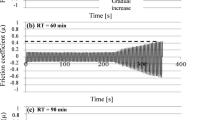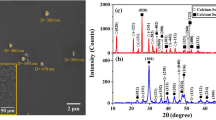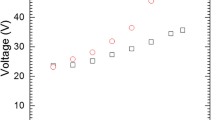The efficiency of thorough anodic oxidation of ASTM A356 aluminum alloy as an alternative to painting its surface is studied. Microstructure, phase composition, and microhardness of oxidized layers of various thicknesses (45, 65, 80 and 90 μm) are determined. Solid particle erosion tests are conducted in accordance with ASTM G76 and MIL STD 3033. It is established that with an increase in oxidized layer thickness aluminum alloy wear resistance is reduced and the surface roughness is reduced.







Similar content being viewed by others
Change history
07 December 2023
A Correction to this paper has been published: https://doi.org/10.1007/s11041-023-00943-w
References
ASTM B26/B26 M-18E1. Standard Specification for Aluminum-Alloy Sand Castings, ASTM International (2018).
BS EN 1706 Standard. Aluminum and Aluminum Alloy Castings Chemical Composition and Mechanical Properties (2010).
ASM Handbook Volume 2. Properties and Selection; Non-Ferrous Alloys and Special Purpose Materials, ASM International (1990).
ASM Handbook Committee, Surface Engineering, ASM Handbook Volume 5, Electronic version, ASM International (1994).
A. Torrescano, M. Jeanette, M. Curioni, et al., “Effect of anodizing conditions on the cell morphology of anodic films on AA2024-T3 alloy,” Surf. Interface Anal., 51(12), 1135 – 1143 (2019).
L. Lai, Y. Sun, H. Wu, et al., “Enhanced adhesive strength between SU-8 photoresist and titanium substrate by an improved anodic oxidation method for high aspect-ratio microstructures,” J. Micromech. Microeng., 29(4), 1 – 10 (2019).
R. Sola, L. Tonelli, P. Shashkov, et al., “Anodizing of AA6082-T5 by conventional and innovative treatments: microstructural characterization and dry sliding behaviour,” Wear, 458 – 459, 203423 (2020).
L. Shaohua and J. Wang, “The technical support of nanoart: anodization process,” Anti-Corrosion Method. M., 66(2), 242 – 250 (2019).
Z. Sarajan,“Preparation of A356 foam aluminum by means of titanium hydride,” Met. Sci. Heat Treat., 59, 352 – 356 (2017).
E. O. Gordeeva, I. V. Roslyakov, A. I. Sadykov, et al., “Formation efficiency of porous oxide films in aluminum anodizing,” Russ. J. Electrochem., 54(11), 990 – 998 (2018).
D. Elabar, T. Hashimoto, J. Qi, et al., “Effect of low levels of sulphate on the current density and film morphology during anodizing of aluminium in chromic acid,” Electrochim. Acta, 196, 206 – 222 (2016).
H. Zhu, Y. Xu, Y. Han, et al., “Self-powered electrochemical anodic oxidation: A new method for preparation of mesoporous Al2O3 without applying electricity,” J. Nano Res., 8(11), 3604 – 3611 (2015).
C. K. Chung, M. W. Liao, H. C. Chang, and C. T. Lee, “Effects of temperature and voltage mode on nanoporous anodic aluminum oxide films by one-step anodization,” Thin Solid Films, 520(5), 1554 – 1558 (2011).
H. Elkilany, A. Hagar, M. Shoeib, et al., “Influence of hard anodizing on the mechanical and corrosion properties of different aluminum alloys,” Metallog. Microstruct. Anal., 8(6), 861 – 870 (2019).
M. Sieber, R. Morgenstern, I. Scharf, and T. Lampke, “Effect of nitric and oxalic acid addition on hard anodizing of AlCu4Mg1 in sulphuric acid,” Metals, 8(2), 139 (2018).
Y. Yang, J. Shen, X. D. Yan, et al., “Effect of alloying elements on the quality of hard anodic oxidation film in aluminum alloy 6061,” Rare Metal Mat. Eng., 40(3), 59 – 62 (2011).
R. T. Hitchcock, “Testing of hard anodic-oxidation coatings,” Trans. Inst. Met. Finish., 69, Part 3, 100 – 106 (1991).
ASM Handbook Committee. Metallography and Microstructures ASM Handbook. Vol. 9, Materials Information Company (2004).
Metallic and Other Inorganic Coatings – Vickers and Knoop Micro-Hardness Tests, TS 6503 EN-ISO 4516 (2003).
Metallic Materials – Vickers Hardness Test-Part, Test Method ISO 6507-1 (2018).
ASTM E92. Standard Test Methods for Vickers Hardness and Knoop Hardness of Metallic Materials (2017).
ASTM G76. Standard Test Methods for Micro-Indentation Hardness of Materials, ASTM E384 (2017).
ASTM G76. Standard Test Method for Conducting Erosion Tests by Solid Particle Impingement Using Gas Jets, ASTM International (2018).
MIL STD 3033, Department of Defence Particle. Sand Erosion Testing of Rotor Blade Protective Materials, Test Method Standard (2010).
A. W. Ruff and L. K. Ives, “Measurement of solid particle velocity in erosive wear,” Wear, 35(1), 195 – 199 (1975).
TS EN ISO 16610-21. Geometrical product specifications(GPS) — Filtration. Part 21: Linear Profile Filters: Gaussian Filters, International Standards Organization (2013).
EN 10049. Measurement of roughness average Ra and peak count RPc on metallic flat products (German Version), European Standard, Reapproved (2014).
TS 6956 EN ISO4287. Geometrical Product Specifications (GPS) — Surface Texture: Profile method — Terms, Definition Sand Surface Texture Parameters, International Standards Organization (2004).
T. H. Kosel, ASM Handbook Committee, Friction, Lubrication and Wear Technology, Solid Particle Erosion, ASM International (1992), pp. 367 – 396; ASM Handbook, Vol. 18, Electronic version.
L. R. Krishna, A. S. Purnima, and G. Sundararajan, “Acomparative study of tribological behavior of microarc oxidation and hardanodized coatings,” Wear, 261(10), 1095 – 1101 (2006).
P. Kwolek, K. Krupa, A. Ob3ój, et al., “Tribological properties of the oxide coatings produced onto 6061-T6 aluminum alloy in the hard anodizing process,” J. Mater. Eng. Perform., 27(7), 3268 – 3275 (2018).
Author information
Authors and Affiliations
Corresponding author
Additional information
Translated from Metallovedenie i Termicheskaya Obrabotka Metallov, No. 6, pp. 58 – 64, June, 2023.
Rights and permissions
Springer Nature or its licensor (e.g. a society or other partner) holds exclusive rights to this article under a publishing agreement with the author(s) or other rightsholder(s); author self-archiving of the accepted manuscript version of this article is solely governed by the terms of such publishing agreement and applicable law.
About this article
Cite this article
Başyiğit, A.B., Azakli, Z., Gümrük, R. et al. Wear Resistance of Aluminum Alloy A356 After Thorough Anodic Oxidation. Met Sci Heat Treat 65, 379–385 (2023). https://doi.org/10.1007/s11041-023-00941-y
Received:
Published:
Issue Date:
DOI: https://doi.org/10.1007/s11041-023-00941-y




